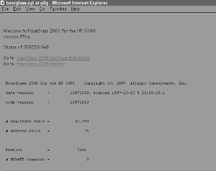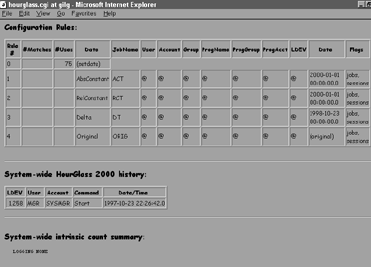TestDrive -- HourGlass 2000: Before the Sand in Your Hourglass Runs
Out
HourGlass 2000: Before the Sand in Your Hourglass Runs Out
NewsWire TestDrive
TestDrive Road Report
HourGlass 2000
Allegro Consultants, Inc.
2101 Woodside Road
Redwood City, CA 94062
Tel: 650.369.2303
Fax: 650.369.2304
E-mail: info@allegro.com
WWW: www.allegro.com
HourGlass 2000 is a software utility that lets you run any job or program
as if the system
clock were set to any MPE-supported date and time (both past and present)
without
affecting any other jobs or programs on your system. HourGlass 2000 does
not alter the
hardware system clock and does not require any programming changes or system
downtime to install.
HourGlass 2000 for the HP3000 runs on all HP3000 Series 900s, MPE/iX 5.0 or
later.
HourGlass 2000 is priced one-size-fits-all at $US 5,900 for the first CPU
with discounts
on additional CPUs. Purchase includes the first year of maintenance. Annual
prepaid
maintenance after the 1st year is 15 percent of the purchase price. A trial
version is
available for downloading at Allegro's Web site.
Review by John Burke
Geesh, just when I thought it was safe to venture out, another Year
2000 tool! But
seriously folks, HourGlass 2000, from Allegro Consultants, is more than
just a Year 2000
tool. It can be an integral part of any software development and testing
program -- and
part of operations. With HourGlass 2000, you can run any job or program as
if the
system clock were set to any MPE-supported date and time (both past and
present)
without affecting any other jobs or programs on your system. HourGlass 2000
does not
alter the hardware system clock and does not require any programming changes or
system downtime to install.
HourGlass 2000 is the HP 3000 implementation of Mainware, Inc.'s HourGlass
2000 product for IBM's MVS. It is not a port, but was developed completely
from scratch
for the HP 3000 by Allegro Consultants. It shares only the name and
functionality of
Mainware's product.
HourGlass 2000 competes in the MPE market with Time Machine (see our
Test
Drive in the September issue). The products have similar functionality
but do differ in
several key areas as noted below.
What can it do?
HourGlass 2000 can be used in any Year 2000 Compliance project to
create a test
bed environment for in-house and third-party software: set the virtual
date/time to
12/31/1999 or 1/1/2000 and watch the results. HourGlass 2000 can:
€ Identify the date/time intrinsics called by any program;
€ Test general date handling of in-house and third-party software;
€ Rerun week-, month- or year-end procedures after the fact with the
correct date;
€ Test modified week-, month- and year-end procedures in advance; and
€ Run non-Year 2000 compliant software after 1/1/2000.
How does it work?
Once started, HourGlass 2000 will intercept all system date and
time calls from all
processes until explicitly stopped or until the system is rebooted.
However, it does not
alter any dates or times unless told to by the HGDATE command or the
HGCONFIG.PUB.SYS configuration file (see the
figures for the format of the configuration
file and examples of HourGlass 2000 at work).
The virtual date and time is only visible to the process (which
includes the CI)
that activates HourGlass 2000 (either by command or automatically via the
configuration
file) and all its descendant child processes, whether in a job or session.
Thus different
programs or even different instances of the same program can be set up to
see different
virtual time. Note that a STREAM'd job is not a child process, but a
separate entity to
which the rules in the configuration file will be applied without regard to the
STREAMing entity.
Features
HourGlass 2000 provides the following four methods for date/time
calculation:
€ Relative constant: start at a given date/time and advance with the
system clock;
€ Absolute constant: always return the same date/time;
€ Delta: add/subtract a given delta time from either the real
date/time or the current
altered date/time and advance with the system clock;
€ Original: "real" time. Cancel a prior HGDATE command or exempt a
session/program
from date/time alteration.
When a process is created, HourGlass 2000 uses the following decision
model to
determine how to handle calls to date/time intrinsics:
€ Search the configuration file for the first "ALWAYS" rule that
matches the process. If
you find none, then
€ Search for an HGDATE command in effect for the job/session within
which the process
was created. If none, then
€ Search the configuration file for the first non-"ALWAYS" rule that
matches the process.
If none, then
€ Use the "real" date/time.
 HourGlass 2000's logging facility gives you the ability to determine
which jobs,
sessions and programs call standard system date intrinsics. Under
administrator control,
a record can be written to the log file for each intrinsic call or a single
summary record
can be written at process termination time. You can disable the
date-altering functions
but still maintain logging if desired for program auditing purposes.
HourGlass 2000's logging facility gives you the ability to determine
which jobs,
sessions and programs call standard system date intrinsics. Under
administrator control,
a record can be written to the log file for each intrinsic call or a single
summary record
can be written at process termination time. You can disable the
date-altering functions
but still maintain logging if desired for program auditing purposes.
 A neat feature of HourGlass 2000 is a CGI-bin program that can be used
to display
the HourGlass 2000 status and accumulated statistics. You must run a Web
server on
your HP 3000 (Shown are examples using Apache/iX).
A neat feature of HourGlass 2000 is a CGI-bin program that can be used
to display
the HourGlass 2000 status and accumulated statistics. You must run a Web
server on
your HP 3000 (Shown are examples using Apache/iX).
Installation and documentation
HourGlass 2000 can either be downloaded from Allegro's Web site or loaded from tape.
Installation of HourGlass 2000 does not
require any system downtime and usage does not require any code
modifications.
Allegro provides two ways to download HourGlass 2000 from its Web
site. The
"easy way" requires only that you have some way (FTP, Reflection, WS92) to
upload a file
from your PC to the target HP 3000. The "other way" requires Telamon's LZW
program.
The "easy way" is neat in its use of uuencode/uudecode and tobyte/frombyte
and the fact
that it is self-contained. The downside is the size of the 1.4 Mb file you
have to
download. The "other way" requires a download only about half the size. So,
if you have
a relatively slow Internet connection, you might want to use the "other
way." I tried
both,and both approaches worked without any problem.
If your HP 3000 is connected to the Internet, you can automatically
validate your
trial version. I was not able to test this, but it is a cool idea anyway.
If your HP 3000 is
not connected to the Internet, you need only e-mail your HPSUSAN and
Allegro will e
mail you back an authorization code good for one week. One minor nitpick: my
authorization code was 70 characters long including spaces! For those of us
who are
keyboard challenged, this can be an Everest to climb. Fortunately, I could
use cut and
paste. But the question remains, why 70 characters?
The documentation is complete and includes many examples. Note: the
reference
manual can be downloaded from Allegro's Web site for your review prior to
downloading a trial version.
Comparisons
HourGlass 2000 and Time Machine (see the Time
Machine TestDrive in the
September 1997 issue of the NewsWire) differ in two major ways: granularity
of system
configuration rules and the way dates and file system intrinsics are handled
HourGlass 2000 has a much richer scheme for defining logon time
behavior (See
the figure for an example of the configuration file). You can literally
define it down to: a
specific program run by a specific user (sessionname,user.account,group) in
session
mode on a specific LDEV will see a modified system time and all other
activity by that
user will see true time. Time Machine will only let you define time
behavior by user
(sessionname,user.account,group), in a manner similar to a logon UDC, but
easier to
administrate.
HourGlass 2000 intercepts all date/time requests, including those
associated with
file create/modify/access. This may be desirable during testing, but could
lead to
problems later on with, for example, backups and normal processing. Allegro
provides a
utility program with HourGlass 2000 to find and fix all files on the system
with a future
date. Time Machine takes a different approach to file dates -- the virtual
clock is only
visible to user programs and user libraries. All file system timestamps
will remain on true
time, for example. This makes Time Machine easier to use for time shifting:
allowing
users to see their local time in screens and reports while still keeping
application time
synchronized.
Both HourGlass 2000 and Time Machine do what they claim to do very
well. If you
are comparing the two products for possible purchase, you will have to
decide the
relative importance of each of these differences and how each would impact your
operation.
Conclusion
There has been a need for something like HourGlass 2000 since long
before the
Year 2000 Problem appeared on IS radar scopes. Rigorous program testing demands
such a tool. The inevitable report/process reruns we deal with are made
easier with such
a tool. Take a look at HourGlass 2000. Its usefulness will long outlast
your Year 2000
Compliance projects.
Copyright 1997, The 3000 NewsWire. All rights reserved.
 HourGlass 2000's logging facility gives you the ability to determine
which jobs,
sessions and programs call standard system date intrinsics. Under
administrator control,
a record can be written to the log file for each intrinsic call or a single
summary record
can be written at process termination time. You can disable the
date-altering functions
but still maintain logging if desired for program auditing purposes.
HourGlass 2000's logging facility gives you the ability to determine
which jobs,
sessions and programs call standard system date intrinsics. Under
administrator control,
a record can be written to the log file for each intrinsic call or a single
summary record
can be written at process termination time. You can disable the
date-altering functions
but still maintain logging if desired for program auditing purposes. A neat feature of HourGlass 2000 is a CGI-bin program that can be used
to display
the HourGlass 2000 status and accumulated statistics. You must run a Web
server on
your HP 3000 (Shown are examples using Apache/iX).
A neat feature of HourGlass 2000 is a CGI-bin program that can be used
to display
the HourGlass 2000 status and accumulated statistics. You must run a Web
server on
your HP 3000 (Shown are examples using Apache/iX).